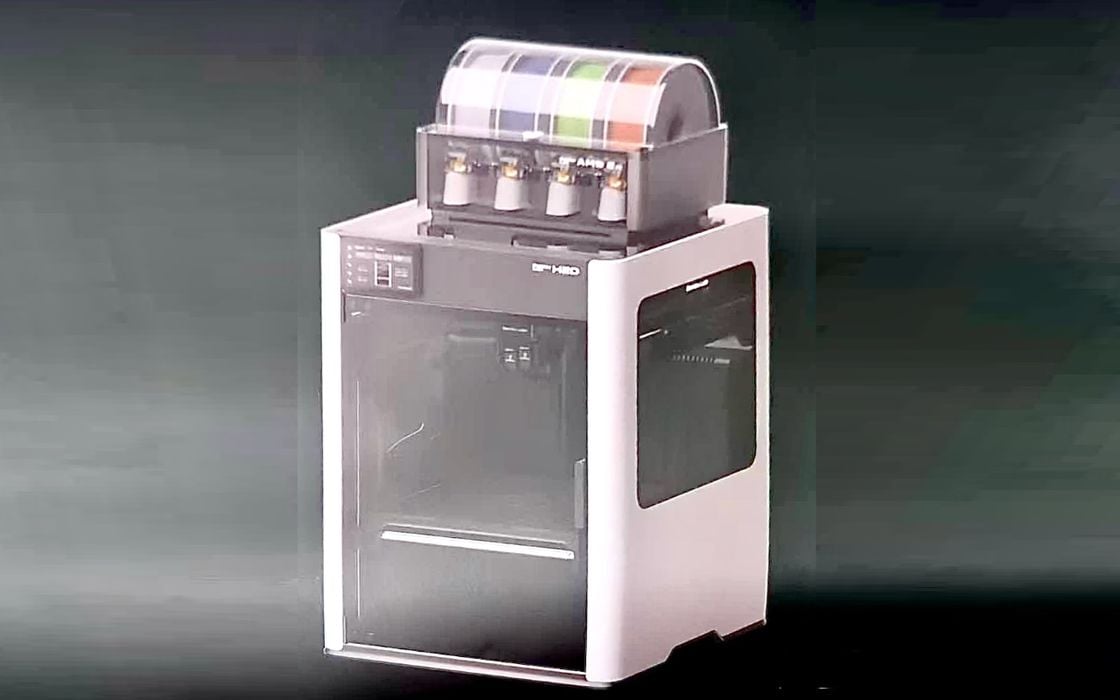
In a possible major leak, a document that might depict an unannounced Bambu Lab 3D printer has appeared.
Posted this weekend on the Bambu Lab subreddit without explanation, the image seems to be a packaging insert for a Bambu Lab machine we haven’t seen yet, the “H2D”.
Here’s the raw image:

At the top, I enhanced the image in an attempt to see what this machine looks like without the distortions from the original image.
There is some brief text on the image:
Bambu Lab H2D Combo
H2D Dimensions: 492514626 mm3
AMS 2 Pro Dimensions: 372280226 mm3
Package Size: 620620755 mm3
At the top of the page, there is “跳距550MM”, which translates as “jump distance 550 mm”.
Where Did This Image Come From?
It could be that someone working at the printing company that produces the package inserts might have leaked this image. If so, it could be the mystery 3D printer that Bambu Lab was to release in the Fall, but later delayed the release until early next year. Rumors at the time suggested the mystery 3D printer would have a larger build volume.
Analyzing the Bambu Lab H2D Image
What are we to make of all this?
Assuming this is a real package insert of a machine that could be announced shortly, let’s see what we can learn by examining the data.
The “H2D” name would be a new line for Bambu Lab, which currently has X, P, and A as their product prefixes. “H”, when used by other companies, has often indicated “high temperature”. Could the H2D be a high-temperature (e.g. 400-450C) machine? If so, it would be capable of printing a wide range of exotic engineering materials.
But what about the “2D” part of the name? If we look closely in the build chamber, the toolhead appears to be quite different from those on all existing Bambu Lab equipment.
It appears to have dual toolheads, with one raised — that would explain the “2D” portion of the product name. This is an approach we’ve seen previously to implement dual extrusion. The active nozzle is positioned lower, and the unused nozzle is raised to avoid interference with the print.
This approach would dramatically reduce the amount of poop that is typically generated during multimaterial operations on Bambu Lab equipment. There would be no need to purge the “other” nozzle, because it just sits aside, ready to go.
The only catch is that Bambu Lab would have to devise some method of avoiding drips from the unused nozzle. This might be done through some form of retraction, or perhaps they have a cover that slides over the unused nozzle. Either way, the nozzles would be kept hot for near-instant material changes.
But hold on, what about the “AMS 2 Pro”? Wouldn’t that be used for multiple materials? It certainly would. There are some interesting dynamics here: perhaps you’d put the most used material on one nozzle, and thereby reduce poop significantly. Or the slicer could figure out which pair of materials are best kept alongside each other to reduce poop for a given print job.
Another question is how the AMS 2 Pro loads the dual nozzles? Or does it? Is one nozzle dedicated to support material, for example, with the other one for AMS swapping? Maybe the second toolhead is for challenging materials like TPU, which currently can’t be used in an AMS due to their spaghetti-like properties.
An observation on the AMS 2 Pro: it doesn’t seem to be stackable. Does that mean only one 4-spool unit is usable on the H2D? Could you attach an AMS 2 Pro to each nozzle at the same time? How do you position them? Because it isn’t stackable, I’m betting that you would normally attach an AMS to only one nozzle.
The AMS 2 Pro image seems to be nearly identical to the current AMS unit, so any improvements are mostly invisible. Perhaps it includes a drying feature, as do many competing units? That would be quite appropriate for high-temperature materials that are typically hygroscopic.
Many questions about filament management here.
Bambu Lab H2D Build Volume Speculation
Now let’s look at the numbers. The H2D’s external dimensions are allegedly 492 x 514 x 626 mm, but the build volume is not listed. Could we compare this to the X1C’s dimensions and come up with an estimated build volume? I think we could.
The X1C’s build volume is 256 x 256 x 256 mm, with external dimensions of 389 x 380 x 457. This suggests that space beyond the build platform on the X1C would be 133 x 133 x 201 mm (this plus the build volume equals the external dimensions).
If we assume the same space overhead on the H2D, and subtract that overhead from the stated external dimensions and round off the numbers, we get something like 350 x 350 x 420 mm as the estimated build volume of the H2D 3D printer.
But wait — there was that blurb at the top of the insert that said “jump distance 550mm”. Could that mean the Z-axis is actually 550mm? That would actually fit into the height of the enclosure, leaving a slim 76mm.
Either way, that’s quite a bit larger, and is competitive with the Prusa XL, which offers a 360 x 360 x 360 build volume. In fact, if these estimated dimensions hold, the Z-axis would be substantially taller.
Interestingly, this build volume — and possible high-temperature capability — would be comparable to Stratasys’ F190CR, F370CR, F170, and F370 industrial 3D printers. This could explain Stratasys’ sudden interest in Bambu Lab and the patent infringement lawsuit launched after Bambu Lab indicated they were to announce a new machine.
On the other hand, this is all entirely speculation based on a questionable image, and the truth could be wildly different.
Either way, Bambu Lab will definitely announce something new in the next few months. It may be the H2D, or maybe not.
Via Reddit
